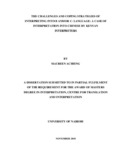| dc.contributor.author | Achieng, Maureen | |
| dc.date.accessioned | 2019-01-23T09:37:46Z | |
| dc.date.available | 2019-01-23T09:37:46Z | |
| dc.date.issued | 2018 | |
| dc.identifier.uri | http://hdl.handle.net/11295/105331 | |
| dc.description.abstract | The study is on the challenges and coping strategies used by Kenyan interpreters who
interpret into Chinese as either their B or C language. There were 42 respondents in the
research who are all working as either freelance or inhouse interpreters. A questionnaire
was distributed to the 42 respondents and two speeches were sent to 4 interpreters for
observation. From the analysis the following was revealed: Kenyan- Chinese interpreters
interpret into Chinese which is a C language for many. However, majority of the
interpreters still prefer interpreting into English which is either their B or A language.
While interpreting into a C language, the interpreters have several challenges at the
deverbalization and reformulation stage. They have therefore come up with coping
strategies which are mainly used at the reformulation stage. The challenges and strategies
used vary form one interpreter to another depending on their language proficiency,
training and experience in interpretation. Regardless of the challenges encountered, the
interpreters were able to pass a message. | en_US |
| dc.language.iso | en | en_US |
| dc.publisher | University of Nairobi | en_US |
| dc.rights | Attribution-NonCommercial-NoDerivs 3.0 United States | * |
| dc.rights.uri | http://creativecommons.org/licenses/by-nc-nd/3.0/us/ | * |
| dc.title | The Challenges and Coping Strategies of Interpreting Into B and/or C- Language: a Case of Interpretation Into Chinese by Kenyan Interpreters | en_US |
| dc.type | Thesis | en_US |



